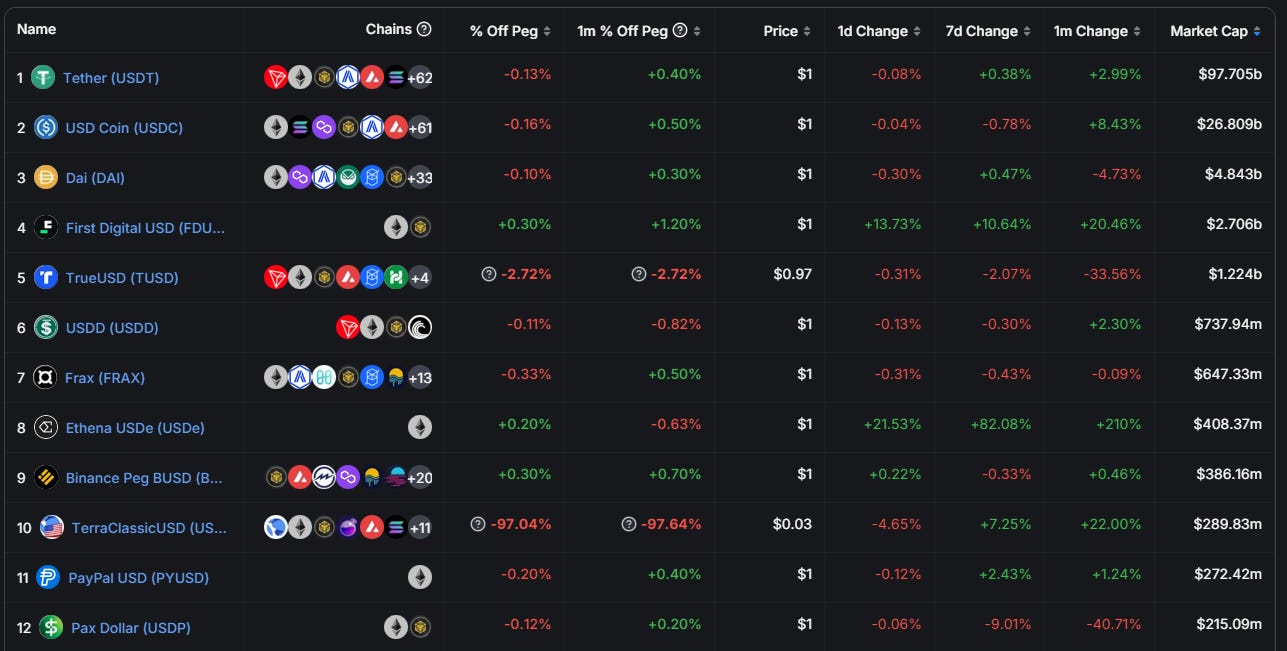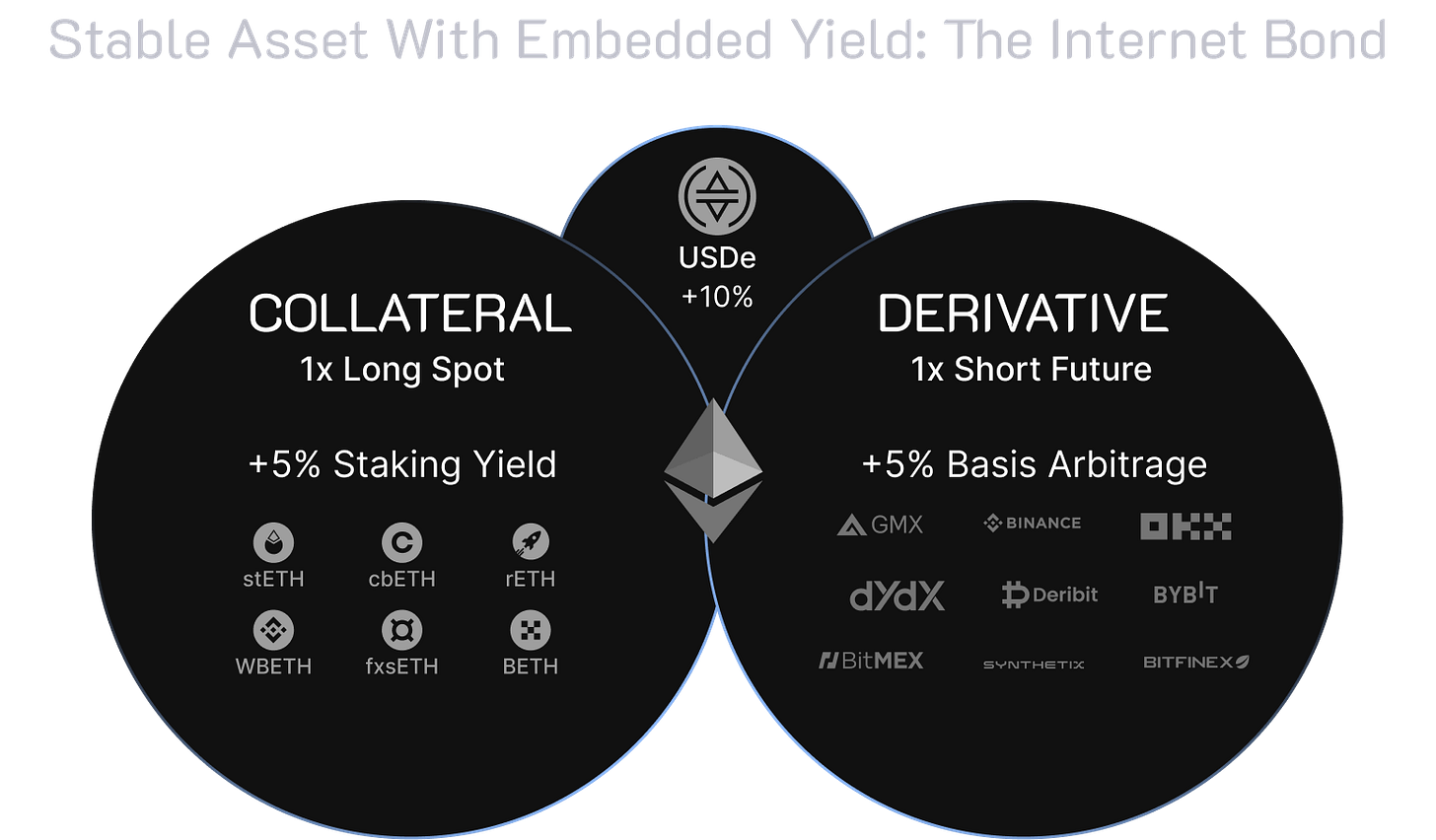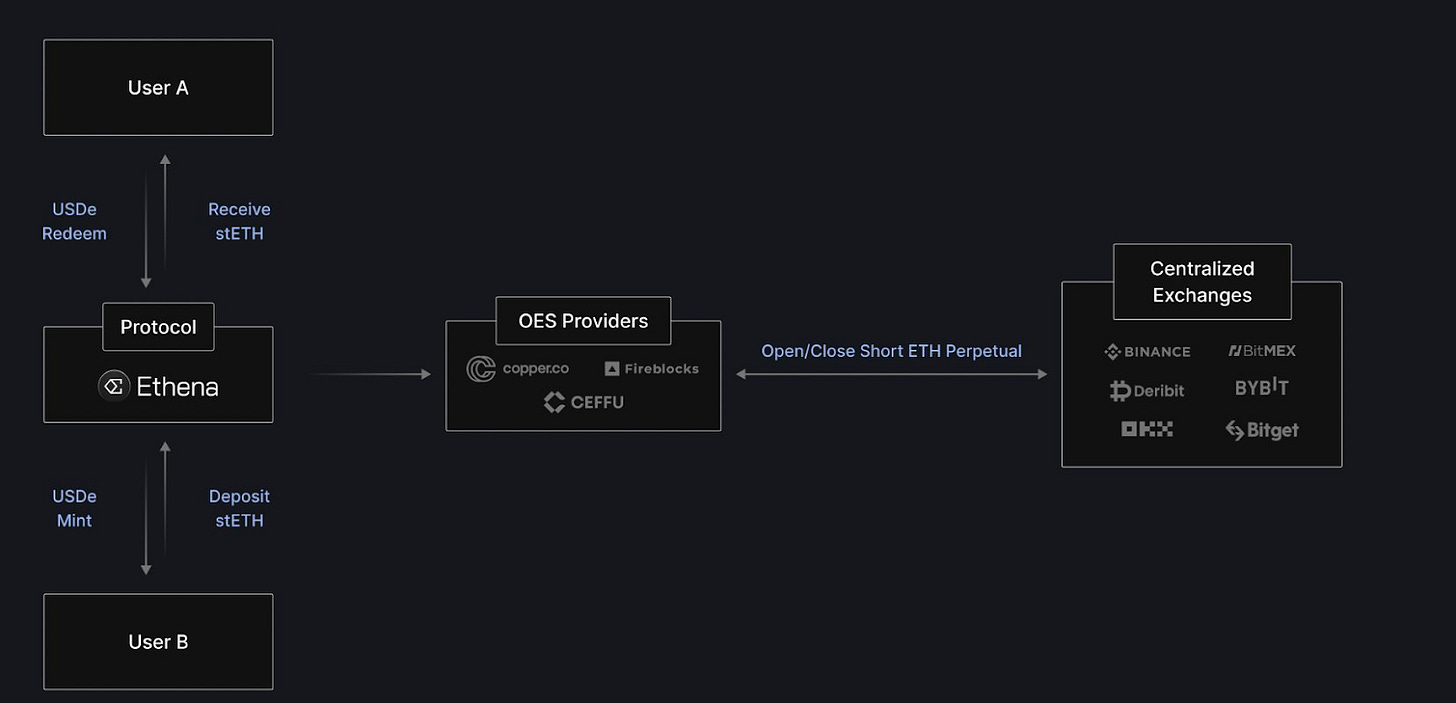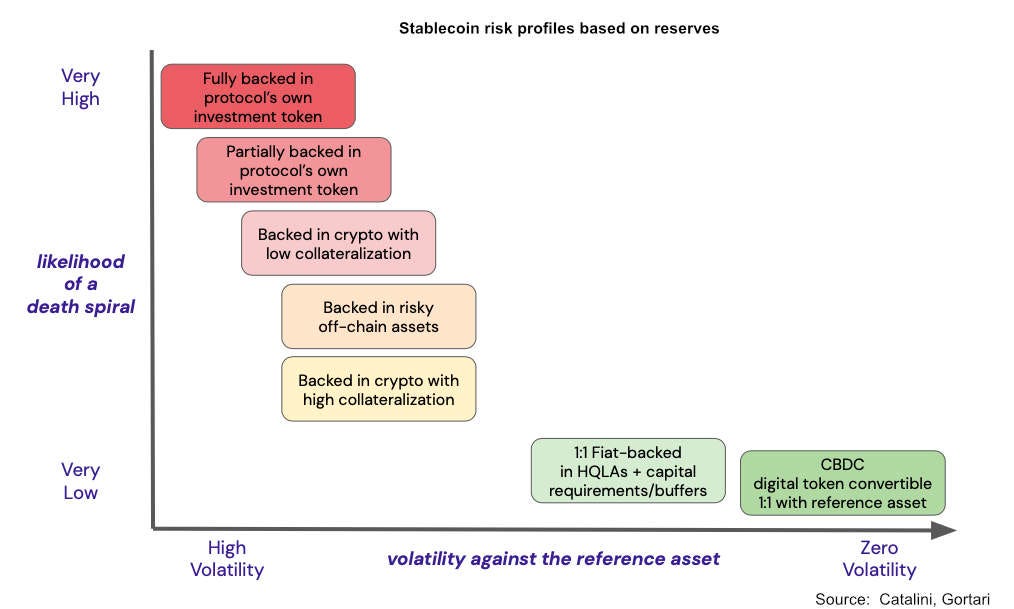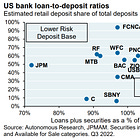Today we highlight the following:
STABLECOINS: USDe is the latest stablecoin and it is offering 27% yield
CURATED UPDATES: Financial Institutions and Adoption; DeFi and Digital Assets; Blockchain Protocols; NFTs, DAOs and the Metaverse
To support this writing and access our full archive of newsletters, analyses, and guides to building in the Fintech & DeFi industries, subscribe below.
STABLECOINS: The latest stablecoin USDe is offering a 27% yield
Stablecoins are one of the established killer use-cases of blockchain protocols, currently accounting for around 7% of the market share of all cryptocurrencies with a total market cap of $140B. We believe this number is set to increase to $1 trillion over the next 5 years as cash and payments move onchain.
Currently, the space is led by USDT (Tether), which accounts for a 70% share of the stablecoin market, trailed by USDC (Circle backed tokenized bank deposits) and DAI (Maker’s crypto-collateralized loans). Enter a new entrant — Ethena Labs’ USDe, a delta-neutral collateralized stablecoin, offering 27% yield at current rates. Since launch a week ago, and coinciding with Ethena Labs’ $14MM raise, USDe has attracted $400MM in TVL, beating even PayPal at the money game.
Technically, USDe is not a stablecoin, but a synthetic dollar created by delta-hedging staked Ethereum collateral. Delta-hedging is an options trading strategy that looks to reduce the directional risk associated with price movements of the underlying asset (in this case staked ETH). Ethena Labs does this by establishing offsetting long and short positions for ETH to maintain delta neutrality.
Ethena’s “Treasury Management” system increases or decreases the size of the delta hedging derivative positions when USDe is minted or redeemed for the underlying asset to maintain this neutrality. Put simply, when a portfolio is delta-neutral, its USD value remains constant regardless of market conditions, i.e the fluctuation of the price of ETH. If the price of ETH doubles, the profits are offset by losses from the equal-sized short perpetual position and vice versa.
USDe’s yield is generated from two sources: (1) staked Ethereum rewards and (2) funding and basis spread earned on the delta hedging derivatives positions. ETH staking rewards are around 3.5%, and the current Funding Rate annual yield is around 23-25%. For context, average annualized ETH funding rates were between 6-7.5% over the past 3 years.
This gets tricky to explain. To obtain the Funding Rate yield, short positions are taken out against the underlying stETH. In perpetuals and futures derivatives, if there are more long positions than shorts, like there are during a bull market, then short positions earn a funding interest. ETH markets tend to be long-biased, which means that funding rates tend to stay positive.
Ethena works with companies like Fireblocks and Copper, as well as pretty much all large centralized crypto exchanges, to rebalance their positions based on market movements. However, if this earned rate veers into negative territory, losses are covered by the insurance fund.
One risk for USDe is if funding rates become negative, for instance during a bear market. In this case, Ethena suggests that USDe would leak money rather than experience a drastic draw-down, as was the case with Terra. The insurance fund is expected to become 10% of TVL to manage market risk in the future. Ethena also claims to be less exposed to exchange risk as it utilizes "Off-Exchange Settlement '' providers, like Copper and Fireblocks, to custody backing assets. For more detail, check out our podcast conversation with Ethena below.
No stablecoins are exempt from risk. Major players, like USDC and USDT, are still subject to custody risk, a reliance on traditional banking infrastructure and exposure to a bank’s lending activities. The traditional banking infrastructure risk is important to consider in crypto where country-specific regulations may impact operations. And bank lending activity exposure can be significant, as we were reminded by Silicon Valley Bank.
Algorithmic and collateralized stablecoins, on the other hand, carry financial capital markets and smart contract risk. Many will recall Terra’s collapse, which culminated in the end of the bull run in 2022 and the fall of many of the industry’s biggest names. This stablecoin PTSD may be just what we needed to bring greater scrutiny to novel designs. Governments are now also beginning to look at stablecoins seriously, hopefully bringing an added level of rigor to risk assessments. This week the UK’s Treasury minister said that he expects laws on stablecoins within the next 6 months.
Stablecoin usage can also be manipulated to inflate the perceived usage of blockchain networks. This is reportedly the case for Solana, which has witnessed a dramatic surge in stablecoin transfer volumes in recent months — up 650% since October 2023. This may be the work of a few market makers moving money back and forth, generating volumes to attract attention to the chain. Yield-generating stablecoins are likely to be a strong magnet to a particular ecosystem as well, as long as the yield is grounded in reality.
There are many different approaches to building a product that has money-like fixed income characteristics. Another project we are watching is M^0, which is creating a crypto dollar that would be mintable by crypto institutions and backed by US Treasury Bills, with end-users benefiting from the respective yield. Their design takes a more deeply institutional and compliant approach, over a capital markets financial engineering product, or a pure Web3 degen leverage product. We remain excited about these financial innovation in large part because they are defining the design space for what will function as money in the century to come.
👑 Related Coverage 👑
With a 35% open rate and 1 million post views per month, we have an engaged audience of Fintech, DeFi, and AI enthusiasts receptive to your messaging.
Contact us to learn more about our custom opportunities.
Curated Updates
Here are the rest of the updates hitting our radar.
Financial Institutions and Adoption
Recent crypto rally driven by 'retail impulse,' says JPMorgan - The Block
Helius Secures $9.5M Series A Funding to Boost Solana-Based App Creation - cryptorank
DeFi and Digital Assets
⭐ Cryptodollar Minting Protocol M^0 Will Allow Institutions to Issue Stablecoins Backed by U.S. Treasuries - Coindesk
⭐ Eigen Labs, Developer Behind Restaking Protocol EigenLayer, Raises $100M From A16z Crypto - Coindesk
Binance Labs invests in Ethereum liquid restaking protocol Renzo - The Block
UK Minister Expects Laws on Stablecoins, Staking Within Six Months - Bloomberg
Solana DeFi Tops $2 Billion in Value Locked for First Time Since June 2022 - Decrypt
Blockchain Protocols
⭐ Starknet’s $2 Billion Airdrop Is Crypto’s Biggest Yet - The Defiant
Starknet Activity Falls Sharply Following Ethereum Airdrop Hype - Decrypt
NFTs, DAOs and the Metaverse
MetaStreet Raises $25M from Angel Investors for Yield-Earning NFT Protocol - NFTGATORS
Paris Saint-Germain Becomes First Soccer Team to Validate a Blockchain - Coindesk
🚀 Level Up
Sign up to the Premium Fintech Blueprint and in addition to receiving our free newsletters, get access to:
Wednesday’s Long Takes with a deep, comprehensive analysis.
‘Building Company Playbook’ series, offering insider tips and advice on constructing successful fintech ventures.
Enhanced Podcasts with industry leaders, accompanied with annotated transcripts for deeper learning.
Special Reports
Archive Access to an array of in-depth write-ups covering the hottest fintech and DeFi companies.
Join our Premium community and receive all the Fintech and Web3 intelligence you need to level up your career.



